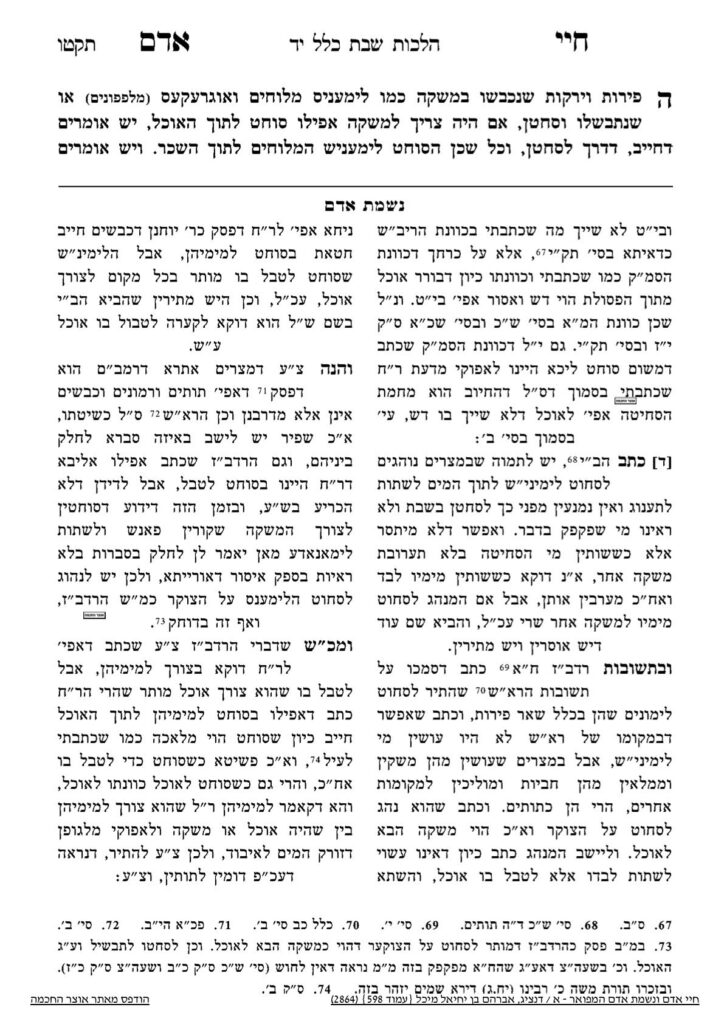Sponsorships for the upcoming Klalim, which discuss the 39 melachos of Shabbos, are available. Please contact Rabbi Reingold for more information at rabbireingold@gmail.com or 301.996.5910
We are continuing in siman 5, discussing kevashim and shelakos.
There are two halachic ways to look at kevashim and shelakos; meaning, there are two ways to look at liquid which has been absorbed into an item. It could be argued that when something which already has the halachic status of a mashkeh (one of seven liquids, such as wine or water) becomes absorbed into a fruit, it loses its previous status of being a mashkeh. Alternatively, it could be argued that it maintains its status as a mashkeh, even while absorbed in the fruit.
The practical difference between these arguments is whether the liquid maintains the status of mashkeh when it is squeezed from the item:
- If the liquid loses its status as a mashkeh when absorbed into the item, the liquid being squeezed is a non-mashkeh. If so:
- If it is squeezed for the purpose of discarding the liquid, it is muttar.
- If it is squeezed into a food, we get into the question of mashkeh ba la’ochel, and we pasken that since the liquid goes from one food (the original item) into another food, it never gains the status of mashkeh.
- If one wishes to use the liquid itself, it will depend on the type of fruit. We know that if it is a grape or olive, the liquid becomes a mashkeh and is assur. If it is a berry or pomegranate (which are sometimes squeezed), it also becomes a mashkeh and is assur. If it is shaar peiros (all other fruits), the Chayei Adam was concerned for the opinion of Rabbeinu Chananel and held it should be assur, but the Shulchan Aruch paskened it is muttar.
- However, if we understand that the original mashkeh status of the liquid which was absorbed was never lost, squeezing out the liquid would be squeezing out mashkeh. As a mashkeh, it would be akin to extracting a kernel from its husk, and would be assur. If so:
- If it is squeezed for the purpose of discarding the liquid, it is no longer the issur deoraysa. The issur deoraysa is to separate the kernel for the husk in order to use the kernel; over here, since one is separating the liquid to discard it, it is not considered dosh and is muttar.
- If it is squeezed into a food, although we generally apply the concept of mashkeh ba la’ochel and it would be muttar, over here it does not apply and would be assur. The concept of mashkeh ba la’ochel is that the liquid begins as part of the food and goes directly into another food, so it never has a chance to gain the status of mashkeh. Over here, if it began as a mashkeh, it already is a mashkeh when squeezed out of the first food, so the heter does not apply.
- Certainly, if one squeezed out the liquid for use of the liquid itself, it would be assur mideoraysa.
- Shelakos and kevashim are unique in that the liquid within them is not their natural juice, but rather absorbed through the cooking or pickling process. Therefore, it is a machlokes whether the liquid absorbed is considered a mashkeh or not when it is squeezed out.
- If it is not considered a mashkeh:
- If squeezed for discarding–muttar
- If squeezed into food–muttar
- If squeezed for the liquid itself–Muttar as it is like shaar peiros.
- If it is considered a mashkeh:
- If squeezed for discarding–muttar
- If squeezed into food–assur
- If squeezed for the liquid itself–assur.
- If it is not considered a mashkeh:



